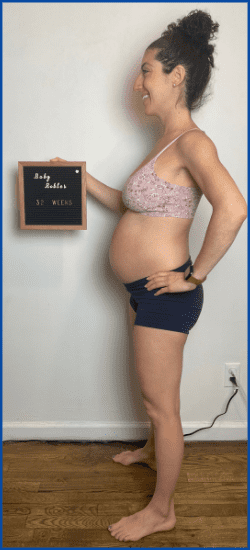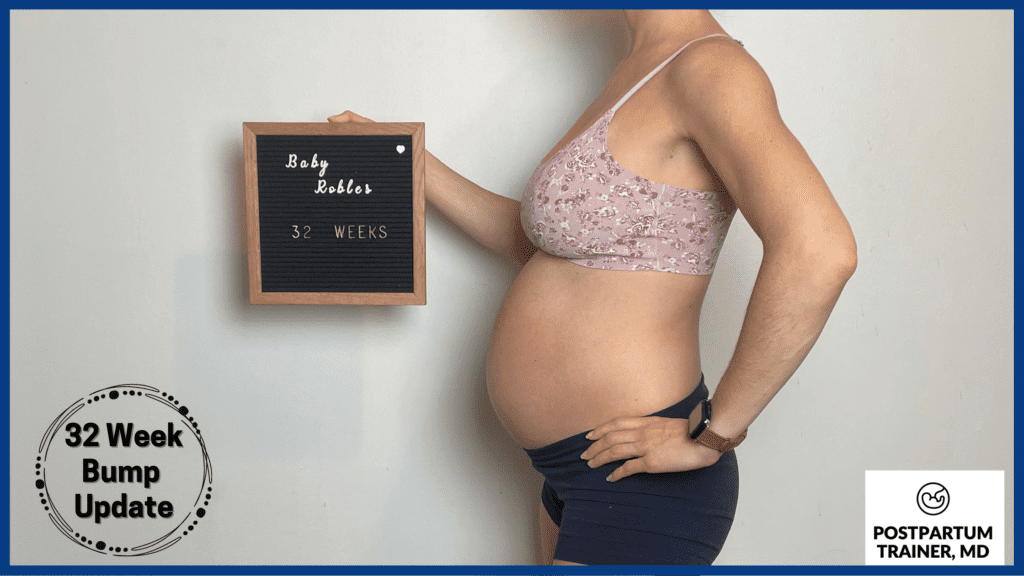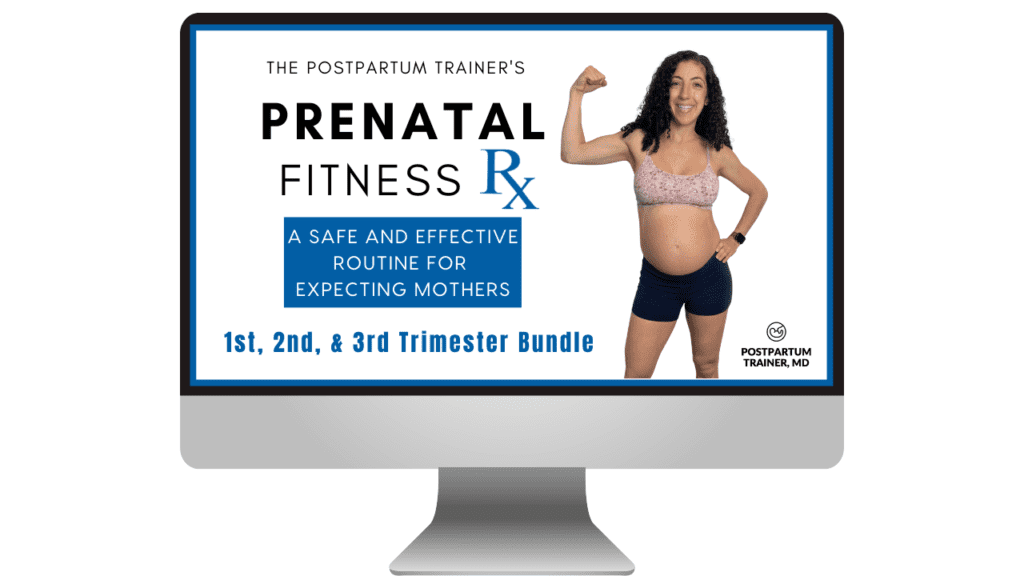My 32 Weeks Pregnant Belly Picture

Starting Weight: 123lbs
Current Weight: 137lbs
Total Weight Gain: 14lbs
Now let’s go over how my week went and what to expect…
Energy Level: No significant changes to my energy level this week.
Pregnancy Symptoms: At this point in the pregnancy, things are starting to get uncomfortable. I still have my Braxton Hicks contractions on a daily basis, and I will occasionally feel pelvic pressure, especially when he is moving around a lot. There isn’t much I can do to help the symptoms except for taking it easy and just resting when I get home from work.
Also, I continue to experience bilateral leg cramps throughout the night. I noticed that if I massage the calves prior to going to sleep, this seems to control the symptoms.
Other Physical Changes: No other noticeable changes besides my growing belly :). I can also see my belly button completely.
Diet: My diet was quite normal this week.
Check out this video to see what I eat on a typical day.
Here is a list of some healthy snacks you can try.
Diet Modifications: The biggest change that I have had to make to my diet is having to consume smaller meals than I am used to. These days, my stomach gets full quickly, which I attribute to my diaphragm rising up higher into my chest.
Food Aversions: No food aversions this week.
Food Cravings: No real food cravings. I think that having a well-balanced diet that contains all of the nutrients my body needs is key to controlling cravings.
Workouts: This week I completed my usual four strength workouts (squat, overhead press, bench, and deadlift) in addition to two peloton rides.
I feel really proud of myself for being able to keep up with my strength and cardio routines at 5 o’clock in the morning before work.
You can see examples of my entire pregnancy workout in my Prenatal Fitness Prescription.
Modifications to my workout: The only modifications I have made to my workouts are using lighter weights and avoiding being on my back for prolonged periods of time.
For each barbell exercise, I always ensure that I am going through the movements carefully to minimize the risk of injuring myself.
I have also modified my ab workouts to ensure that none of the exercises cause coning.
As far as my peloton classes go, I always make sure to avoid any excessive shortness of breath.
Here is a video of me performing incline push ups using a bench.
*Be sure to speak with your health care provider before doing any physical activity or heavy lifting in pregnancy.*
Other Related Questions
How big is the baby at 32 weeks?
At 32 weeks of pregnancy, your baby is about 16.5 inches in length and about 4 lbs in weight, on average.
This is about the size of a squash.
Here is what my belly bump looks like at 32 weeks:

When checking a fundal height, the top of your uterus should be anywhere from 30-34 cm from your pubic bone.
What does a baby look like at 32 weeks?
A 32-week baby looks like a full-term baby, just a lot smaller with less fat underneath its skin. The baby is also growing some toenails and fingernails!
In addition, the baby will have lanugo, which is the fine hair that is present in some babies at birth.
This hair will usually fall off within a few weeks.
Are babies fully developed at 32 weeks?
Babies are well developed at 32 weeks, however many of their organs like the brain, lungs, and digestive system will continue to develop until they reach full term.
How can you tell if baby is head down at 32 weeks?
There are two ways to determine if a baby is head down at 32 weeks.
- Ultrasonography
- Leopolds manuever
Ultrasonography is a quick and definitive way to determine the position of your baby. An ultrasound can easily be performed at your doctor’s office in less than a minute.
The second method is Leopold’s maneuver. Leopold’s is a method of using your hands to externally palpate the uterus in an effort to determine fetal size and position.
This maneuver is how the position of the baby was assessed before the use of ultrasound machines.
Leopold’s approach is less reliable and requires someone with experience to do it accurately. If your baby is in the breech position, you will need a cesarean section.
Can labor start at 32 weeks?
Yes, labor can start at 32 weeks. Preterm labor can start anywhere between 20 to 37 weeks.
Preterm labor is defined as regular painful uterine contractions that is causing your cervix to dilate before 37 weeks.
Unfortunately, pregnant women with a history of preterm labor, are at high risk of going into preterm labor again.
If you are in preterm labor, you will be admitted to the hospital and given steroids to enhance the maturation of your baby’s lungs (as the lungs do not mature until the baby reaches full-term) and medications to try and stop the labor temporarily.
The pediatrics team will also be called to speak with you about the management and care of a preterm baby.
What are signs your baby will come early?
Signs that your baby will come early can include:
- Regular painful preterm contractions
- Breaking your water before 37 weeks
- Painless dilation of your cervix before 37 weeks
- Heavy vaginal bleeding
With that said, it is possible that you deliver early without any signs of labor.
What should you not do at 32 weeks pregnant?
At 32 weeks you should not:
- Lay down flat on your back
- Engage in high risk activities that increase your risk of you falling
- Be in high temperatures for prolonged periods of time
- Perform excessive exercise to the point of exhaustion
- Have intercourse if you have been diagnosed with placenta previa or insufficient cervix
Is 32 weeks considered 8 months pregnant?
Yes, at 32 weeks you have completed 8 months of pregnancy!
Congratulations on making it this far!
Do babies sleep more at 32 weeks?
Sleep cycle length and duration vary widely among fetuses.
Nevertheless, it is still important to pay attention to how often your baby is moving, as decreased fetal movement can be a cause of concern.
Ideally, you should feel your baby moving at least 10 times in two hours.
If you do not feel this, try drinking something sweet, and go into a quiet room so you can really focus on the movements.
If you still do not feel movement you should go to the nearest labor and delivery unit.
Why do I need a 32 week ultrasound?
Typically if you have had a normal pregnancy, you do not get an ultrasound at 32 weeks.
However, if you have a medical condition that can affect your pregnancy, your healthcare provider may order you for a third-trimester ultrasound. Common reasons include:
- Gestational diabetes or pre-gestational diabetes,
- Gestational hypertension/ preeclampsia or chronic hypertension
- Intrauterine growth restriction
- Oligohydramnios or polyhydramnios (low or high amniotic fluid)
You may also undergo antepartum fetal testing beginning at 32 weeks, which consists of a non-stress test (NST) or a biophysical profile (BPP).
A NST is a way to monitor the oxygenation status of your baby through the tracking of their heart rate.
It tracks oxygenation status because the fetal heart rate is an indirect measure of blood flow to the fetus.
The test involves placing two external monitors on your uterus, one to measure your baby’s heart rate and one to measure uterine contractions for at least 20 minutes.
A BPP is a sonographic exam that looks at the movement, tone, and breathing pattern of your baby in addition to the amniotic fluid.
An NST/BPP could be performed weekly or biweekly depending on your condition.
What should I be doing at 32 weeks pregnant?
At 32 weeks pregnant you should be doing your best to maintain a healthy pregnancy. This includes:
- Consuming a healthy and well balanced diet filled with vegetables
- Drinking plenty of water
- Taking your prenatal vitamin
- Taking an iron supplement if you are anemic
- Engaging in moderately intense exercise for 150 minutes per week, if you are cleared to do so by your OBGYN
- Paying attention to your how often your baby moves
- Monitoring for any signs of labor
- Monitoring for any signs or symptoms of high blood pressure
Always speak to your provider for more information unique to your situation.
Common symptoms you might experience at this stage of pregnancy
Now that you are entering the final two months of your third trimester, you might start to experience a worsening of the following pregnancy symptoms:
- Shortness of breath
- Lower back pain
- Difficulty sleeping
- Leg cramps
- Heartburn
- Frequent practice contractions
- Leaking of colostrum from your breasts
- Baby hiccupping (as he is swallowing the amniotic fluid)
Also, you might experience a change in the quality of your baby’s movements. As your baby grows, he or she will have less room in the uterus, and not be able to move as much as before.
Final Words on The 32nd Week of pregnancy
We have finally completed 8 months of pregnancy! Your due date is getting close!
Are you starting to worry about the big day?
Have you started packing your hospital bag?
Comment below and let me and other moms know.
Check back next week for my 33-week update as I enter the last weeks of my pregnancy!
My Other Weekly Updates
- My pregnancy bump at 29 weeks of gestation
- My pregnancy bump at 30 weeks of gestation
- My pregnancy bump at 31 weeks of gestation
Get Four Free Workouts To Help Strengthen Your Pelvic Floor & Heal Your Mommy Tummy!

Brittany Robles, MD, MPH, CPT
Brittany Robles is a full-time OBGYN physician, a NASM certified trainer, and a prenatal and postnatal fitness specialist. She holds a Master of Public Health degree in maternal health with a special interest in exercise and nutrition. She is also the co-author of The White Coat Trainer. Learn more about her here.
Sharing is Caring – Send This To A Mom In Need!
References:
- Marret, S., Ancel, P. Y., Marpeau, L., Marchand, L., Pierrat, V., Larroque, B., Foix-L’Hélias, L., Thiriez, G., Fresson, J., Alberge, C., Rozé, J. C., Matis, J., Bréart, G., Kaminski, M., & Epipage Study Group (2007). Neonatal and 5-year outcomes after birth at 30-34 weeks of gestation. Obstetrics and gynecology, 110(1), 72–80. https://doi.org/10.1097/01.AOG.0000267498.95402.bd
- Suman V, Luther EE. Preterm Labor. [Updated 2021 Aug 11]. In: StatPearls [Internet]. Treasure Island (FL): StatPearls Publishing; 2022 Jan-. Available from: https://www.ncbi.nlm.nih.gov/books/NBK536939/
- Suwanrath, C., & Suntharasaj, T. (2010). Sleep-wake cycles in normal fetuses. Archives of gynecology and obstetrics, 281(3), 449–454. https://doi.org/10.1007/s00404-009-1111-3

